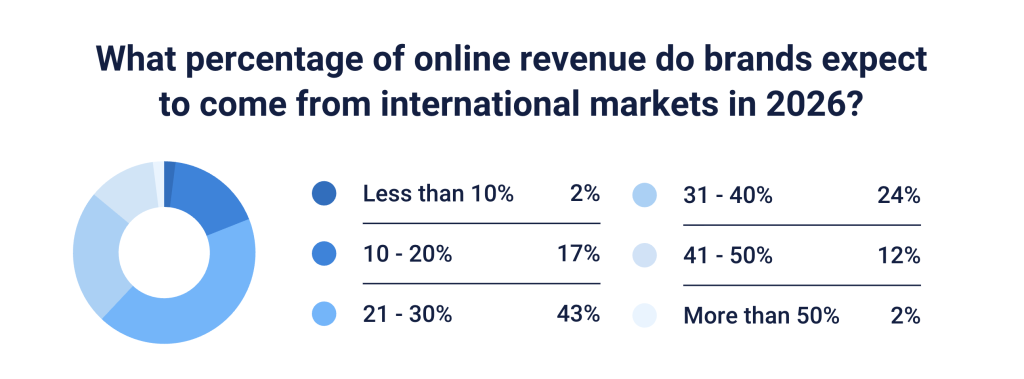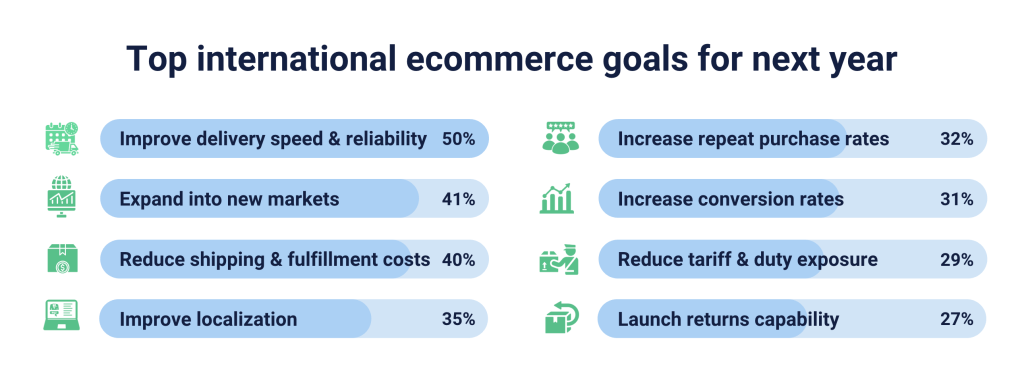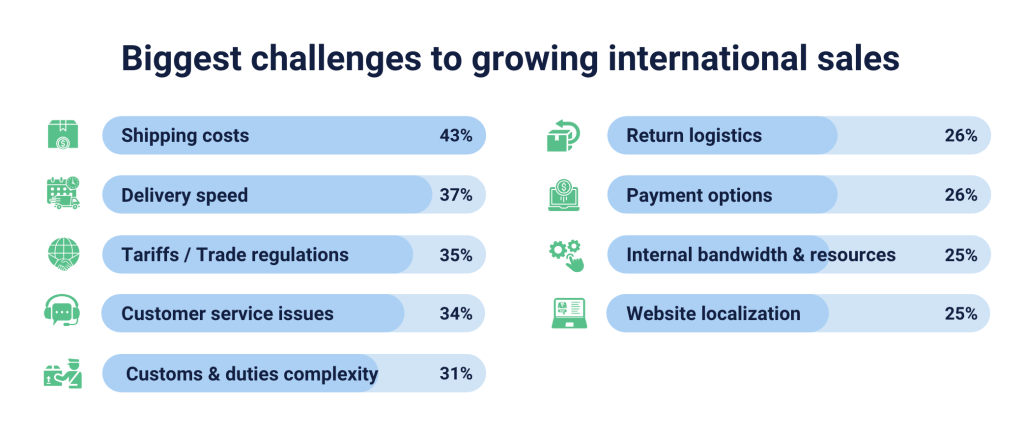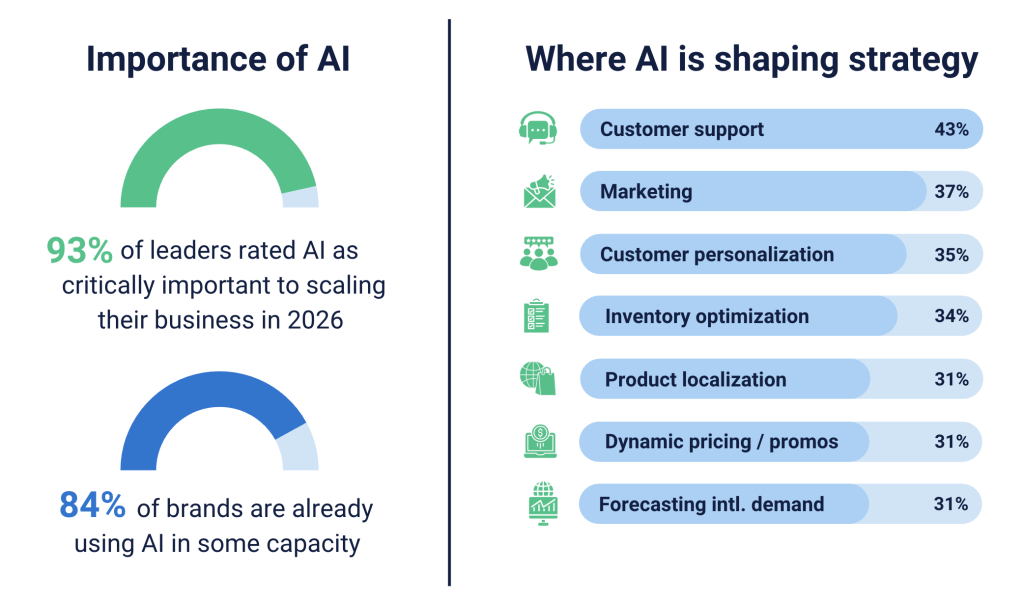
2026 global e-commerce outlook: Growth expectations, tariff risks, and cross-border challenges
2026 global e-commerce outlook: Growth expectations, tariff risks, and cross-border challenges
For global e-commerce leaders, 2026 is shaping up to be a defining year—one marked by strong international demand, heightened regulatory pressure, and rising expectations for speed, accuracy, and reliability. According to an August 2025 study of e-commerce leaders conducted by Passport in partnership with Drive Research, most brands anticipate meaningful growth across international markets next year, but many also acknowledge the operational and compliance challenges that come with it.
Despite economic uncertainty and shifting trade policy, brands aren’t slowing down. They’re planning earlier, coordinating across more teams, and rethinking the infrastructure required to sustain global momentum.
International Growth Expectations Are High for 2026
Nearly every brand expects international demand to rise in 2026, with 98% forecasting growth in global order volume. Most anticipate steady but meaningful gains — over half expect a 1%-10% increase, and 40% predict 11%-25% growth year over year. The message is clear: global revenue remains a crucial driver heading into 2026, even as tariffs, compliance shifts, and fulfillment pressures intensify.

As demand rises, brands also expect a larger share of their total e-commerce revenue to come from international markets. 42.5% anticipate that 21%-30% of their 2026 sales will be international, while 24% expect 31%-40% and 12% project 41%-50%. Only 1.8% foresee flat or declining international sales — underscoring how central global revenue has become to next year’s performance.

Key Priorities Influencing Brands’ 2026 International Strategy
When asked about their top international e-commerce goals for the year ahead, leaders focused on four themes: speed, cost, expansion, and customer loyalty.

Improving delivery speed and reliability leads the list at 50%, followed closely by expanding into new international markets (41%) and reducing shipping and fulfillment costs (40%). Brands are also investing in stronger localization across language, currency, and checkout (35%), as well as boosting repeat purchases, reducing tariff and duty exposure, and building out returns capabilities.
These priorities show a clear shift: Brands aren’t just trying to turn on international markets — they’re focused on building sustainable, profitable, and operationally resilient global revenue.
2026 Planning Is Starting Earlier — and Involving More Teams
Most brands begin planning well before the end of the year. Nearly 70% start their 2026 strategy in Q2 or Q3 — giving teams more time to align forecasts, refine market strategies, and prepare for potential tariff or compliance shifts.

Planning early is only part of the equation. Brands are also taking a more cross-functional approach to international strategy, ensuring decisions aren’t made in silos.
Across the board, brands rely on cross-functional alignment for major international planning initiatives. E-commerce teams lead participation (74%), followed closely by marketing (71%), operations (55%), executive leadership (49%), logistics/supply chain (44%), and finance (27%). External partners also play a role for nearly a quarter of brands.
The result: faster alignment, clearer priorities, and fewer surprises as global pressures continue to evolve into 2026.
Tariffs, Costs, and Compliance Are the Biggest Concerns
Trade uncertainty is shaping nearly every major decision heading into 2026. Three out of four brands are worried about tariff volatility, and many are already adjusting their operations as a result—diversifying suppliers, raising prices, absorbing added costs, and rethinking fulfillment. Together, these actions show how seriously leaders are responding to the shifting trade landscape.

Beyond tariffs, brands pointed to several core obstacles that could make or break their 2026 international strategy. When asked about the top barriers to global growth, leaders cited cost pressure and rising complexity across fulfillment, compliance, and customer experience.

The takeaway: Selling into new markets is the easy part—delivering on those sales is the hard part.
AI Is Accelerating Global Demand—But Also Exposing Operational Gaps
As AI reshapes how shoppers discover and buy, brands are seeing faster conversions, more dynamic order volumes, and rising expectations for accurate landed costs and reliable delivery. The 2025 Passport and Drive Research study found that 84% of e-commerce brands have already adopted AI across marketing, personalization, and customer support. Yet only a third have applied AI to inventory, cross-border logistics, or compliance—the areas most responsible for cost, delivery performance, and customer satisfaction.

This gap is becoming more urgent heading into 2026. AI-assisted shopping, predictive promotions, and conversational commerce are increasing in demand, but they also put pressure on the infrastructure required to fulfill that demand. Faster checkouts are only valuable when supported by faster customs clearance, cleaner product classification, and fewer carrier disruptions.
How Prepared Brands Feel Heading Into 2026
Despite the operational pressures ahead, most brands feel confident about their ability to scale internationally in 2026. More than 90% rated their readiness a 4 or 5, reflecting strong alignment around strategy and early planning. But leaders also acknowledged that this confidence hinges on strengthening the operational side of the business — the systems, partners, and infrastructure needed to support the growth they expect.

When leaders were asked what would most help them succeed next year, their answers converged around the same operational gaps shaping their confidence. Brands want faster and more reliable international shipping, simpler customs and duty management, clearer tax rules, and stronger cross-border logistics partners. Many also emphasized the need for better localization tools—covering language, currency, payment methods, and returns—as well as improved visibility across global operations through unified platforms and market-level insights. These responses show that brands aren’t struggling with demand—they’re struggling with the infrastructure required to serve it.
Operational Readiness Will Define 2026
The brands best positioned for next year won’t simply be the ones with the strongest demand—they’ll be the ones with the infrastructure to support it. As global order volume rises and trade rules evolve, operational strength becomes the deciding factor in whether that demand translates into revenue or risk.
International success in 2026 will require a foundation built on:
- Reliable, predictable delivery.
- Lower landed-cost exposure.
- Clear tariff and duty guidance.
- Flexible fulfillment models that can adapt to policy shifts.
- Better visibility into global operations and inventory.
- Localized checkout and payment experiences.
- Intelligent AI systems that anticipate risks, optimize classification and routing, and connect checkout decisions to real-world delivery outcomes.
- Systems that can scale without breaking.
For many teams, closing these gaps means looking beyond internal resources and collaborating with partners that bring the operational, compliance, and cross-border expertise required to execute consistently across markets.
2026 is a year of opportunity — but only for those building the foundation now. The ones leveraging AI and investing early will be better positioned to navigate volatility, maintain customer trust, and convert global demand into real profit.
This story was produced by Passport and reviewed and distributed by Stacker.



